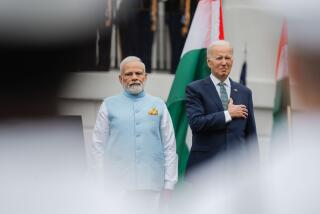National Agenda : India Opens Up the Road to Business : The government is pursuing foreign investors and tearing down regulatory barriers. At last, exporting is honored.
- Share via
BOMBAY, India — P. S. Puri has a dream, one of the millions of ambitious visions energizing India’s economy these days. It’s about a motorbike, parcels and pizza.
Puri’s company, Hero Motors, manufactures a 65-cc two-stroke motorbike, the Hero Puch, originally developed in Austria. Exports numbered just 400 in 1991, but overseas sales last year climbed to 24,000, almost a third of Hero’s total production.
The senior general manager for finance, Puri now has his eye on the American market. The Indian-produced bike, he thinks, would be ideal for express-service couriers weaving through mid-town Manhattan, or deliverymen carrying pizzas in Los Angeles.
Hero Puches already zip along roads in Buenos Aires, Istanbul, Tehran and Stockholm. Puri thinks Hero could sell 20,000 Puches in America each year.
“Virtually the whole world is our market,” says Puri, bubbling with enthusiasm. He is bullish not just about the jaunty two-wheeler that gets more than 210 miles to the gallon but about India too.
For the past three years, the world’s most populous country after China has been undergoing what a New Delhi-based diplomat calls economic “revolution by stealth.”
The government’s regulatory straitjacket has been shredded, freeing entrepreneurs from most of the regulations exercised by haughty babus in government offices. And, for the first time in India, foreign investors are being eagerly wooed.
Although much remains to be done, making India’s economic reforms better known to Americans should be a leitmotif of Prime Minister P. V. Narasimha Rao’s first official visit to the United States, which is scheduled to begin Saturday .
After functioning for more than four decades as a virtual economic island, whose share of world trade fell three years ago to just 0.5%, India and its business elite are hustling to cut themselves a bigger niche beyond their borders.
Exporting has never been more honored. It was announced a few days ago that the Ministry of Home Affairs hopes to hawk abroad the tear gas shells it uses to disperse protesters at home.
The dreams of capitalist entrepreneurs are supplanting the old ideals personified by the aristocratic Jawaharlal Nehru, independent India’s first prime minister.
“At present, there are two groups of people in the world,” Nehru said in 1936. “Out of these two groups, I have no doubt that our country will side with that group which stands for independence and socialism.”
Today, Nehru would be only half right. Socialism, one joke goes, has been supplanted by “Sonyism”--the lust for televisions, videocassette recorders and the other good things that accompany a modern, upscale lifestyle.
It’s true that India is a long way from--and will probably never reach--true laissez-faire economics. The honors paid Nehru and other fighters for Indian independence, the ascetic Mohandas K. Gandhi foremost among them, have kept politicians in Rao’s government from baldly declaring that “to be rich is glorious,” as Deng Xiaoping did in turning China’s economy outward. But the implication seems to be there.
*
A visitor can best see the changes in this bustling, jarring city on the Arabian Sea that is the palpitating heart of Indian business and finance. On the streets now are placards that say “America’s No. 1 engine oil now in India--Pennzoil” and “Buy now, pay later--Citibank Card.”
At Bombay’s airport, East-West Airlines, Jet Airways and other private carriers now compete with state-owned Indian Airways for domestic travelers.
As India, starting in June, 1991, has lowered its tariff walls, liberalized investment rules for foreigners and allowed non-Indians to fully own businesses in most sectors--and implemented other changes--outsiders have gotten excited. In April, India signed the Final Act of the Uruguay Round of the General Agreements on Tariffs and Trade, reaffirming its commitment to integrate itself into the global marketplace.
“Till about two years back, we were basically an insular country, looking inwards rather than outwards,” says Arvind N. Kolhatkar, executive director of the Bombay Stock Exchange. “When India started opening up, the rest of the world realized the opportunity.”
A little number-crunching shows how great the potential is. India has a total population of about 800 million people. There is a “middle class” estimated at 150 million to 250 million people, who can afford at least some brand-name products such as laundry detergent or a dress shirt.
Indians constitute the third-largest pool of engineering talent in the world, it is estimated, and they work in the world’s 10th-largest industrial economy. Its labor force is larger than the entire U.S. population.
“In most sectors, you should be marketing to India now,” John S. Wood, U.S. commercial consul in Bombay, tells visiting American executives. “In most sectors, if you don’t have a presence here in 20, 30 years, you won’t be considered a global player.”
*
At Jardine Fleming India Securities Private Ltd., the company was not ready for the onrush of foreign capital as the government liberalized the rules for foreign investment last year.
“We were going to have 20 research analysts, brokers, etc.,” director Rafiq Dossani recalls. “We expected $200 million in business in the whole year. In just six months, $1.3 billion came in.”
Licensing requirements have been abolished for most industries, except arms and munitions, aircraft and warships, atomic energy, coal and lignite (all still reserved for the government sector), drugs and pharmaceuticals, consumer electronics and a few other items.
Although domestic and foreign investors no longer have to apply for a manufacturing license, they still have to fill out mountains of forms about their intentions and details of production, along with requests for customs clearance and for power, water and telephone hookups.
An old joke, therefore, still has currency: There are two ways of making money in India--managing your business or managing the government.
As India attempts to transform itself, both its people and outsiders are asking what role it will play in the modern world. Will it be the next Asian economic “tiger” growing by ferocious leaps and bounds? Or is the slow-moving elephant a more apt metaphor?
“Anyone who puts money into India expecting massive change in the next few years will be disappointed,” cautions Jardine Fleming’s Dossani, who holds a doctorate in finance from Northwestern University in Illinois. “India should have 5% to 6% growth rates for the rest of the decade.”
For many Indians, used to the “permit raj (rule),” where the government decided which company could make what, freedom will hurt.
“It’s going to be painful for everybody,” predicts Parag Parikh, chairman of a Bombay-based stock brokerage and financial advisory service. “Everybody is going to have to change.”
For the business person, India is at once a country of staggering promise and one of dizzyingly high obstacles. Educated talent is cheap in most fields. “I can hire 20 chartered accountants for the price of an analyst in Hong Kong or the U.S.,” Dossani notes. But if wages are low, he says, so is industrial productivity.
Painfully conscious of China’s dazzling success, Indians know they started their reforms much later but believe they have long-term advantages. Among them: a cumbersome, maddeningly slow but ultimately independent judiciary. And accounting rules that conform to accepted Western standards.
Most important, Indians say proudly, their country is a democracy, with the long-term stability that government by consent of the governed implies.
However, the need for Prime Minister Rao and his courtly finance minister, Manmohan Singh, to build popular consensus for the reforms handcuffs India’s government in terms of how fast it can promulgate change.
“The enthusiasm that had been here for mass-scale privatization--throwing people out of work, closing factories--has been somewhat torpedoed by what happened in Poland and Russia,” says Nair Radhakrishnan, deputy editor of Business India magazine. “The PM is now talking about ‘the middle way.’ ”
Although foreign business involvement in India has soared, the curve has shot upward dramatically because the starting point was low. Last year, two-way U.S.-Indian trade was a record $7.2 billion, but American trade with much smaller Malaysia was twice that.
In textiles and apparel, its strongest export suit, India exported more than $1 billion to the United States, but the Chinese shipped five times that.
As impressive as the sudden flow of foreign capital to the Bombay Stock Exchange and other equity markets was, Indonesia attracted several times more. Foreign direct investment of nearly $3.8 billion over the last three years was a fraction of what China and the nations of Southeast Asia received.
Other signs of the prudent approach: Despite the Rao-Singh reforms that curtailed India’s long obsession with import substitution--building domestic industries to eliminate the cost and job-destroying effect of imports--bringing in consumer goods is still barred. And, as Radhakrishnan notes, the backlash that followed “shock therapy” in the former Soviet bloc helped brake the selling off of state-held companies here, if the process is going forward at all.
By one estimate, only 100 to 150 of India’s state-owned companies are profitable while twice as many run in the red.
In line with Gandhi’s promotion of hand-spinning yarn as the “salvation” for India’s masses, officials still consider it their business to bar companies from firing workers. Any dismissals from a firm employing more than 100 people require approval of the state government, which is usually loath to grant it.
“When business cycles occur, you need the right to adjust your work force, to retrench, to reorganize,” says Keshub Mahindra, chairman of auto maker Mahindra & Mahindra. “Ultimately it’s a matter for negotiations between us and the labor unions. Who in the hell are you, government, to come in and tell us what to do?”
*
As the rules of Indian economics change, the salty-tongued Mahindra and other Indian industrial barons are worried about being snapped up or driven out of business by multinationals.
Dubbed the “Bombay Club” because of a working lunch they held at a posh Bombay club, these moguls are now asking Rao and Singh to give them time to adapt to new conditions. That should also keep the reforms moving at an elephant’s pace.
“We are not afraid of competition,” Mahindra says. “But we want a level playing field.”
That means giving India’s industries a freer hand to hire and fire, like their global competitors. Mahindra, its chairman notes, needed 12,000 employees to turn out 33,000 tractors and 49,000 Jeeps, trucks and small trucks last year, while Maruti, a newer Indian company tied in with Suzuki of Japan, produced 130,000 vehicles with 5,000 employees.
His company shows the potential and problems of Indian industry in a nutshell. Licensed to produce the Jeep in India and the country’s largest tractor manufacturer, it also got into oil drilling and business supplies because the Monopoly Act barred its growth in its core business.
Because of limits on imports, Mahindra was basically on its own: “In years gone by in our business, we made the whole damn thing--engine, axles, body--the whole damn lot. The government compelled you to make every damn thing here.”
For the Bombay industrialist, the world has truly changed. He has sold off the drilling and supplies firms to concentrate on making vehicles and tractors. He is talking with Chrysler about producing the Jeep Cherokee in India and perhaps bolting Mahindra’s diesel engines and transmissions onto imported frames and bodies.
*
And, like other Indian business leaders, he has stopped focusing solely on the domestic market and dreams of a piece of the international action. His company is looking at the possibility of exporting tractors to the United States and has decided to set up a sales network there.
Many questions about India’s potential remain unanswered, not least how the country can modernize its economy and become a major world player while nearly half its people are illiterate and a good one-third live below the poverty line.
In the opinion of economists and business leaders, much remains to be done before the planned and controlled economy built up under Nehru in the 1950s is sloughed off. Still in the future: cutting and rationalizing taxes; further industrial de-licensing and trade liberalization; deregulating the financial sector to allow foreign investment in banking and insurance, and a new hiring-and-firing policy.
The country’s infrastructure, including roads, ports, telecommunications and power, is also sorely inadequate.
But in Bombay and other cities’ business circles, there is an unquestionable climate of optimism caused by the shelving of old ideals that, however noble, failed to end misery in India, and by government’s abandonment of the role of sole planner and regulator of industry and business.
“I think 10 years down the line, if things go the way they are changing, India will be a power to be reckoned with,” predicts Parikh, the stockbroker. “Once we can go full speed, the West will have stiff competition from India, because our growth was curtailed in the past.”
Outgoing Economy India’s exports increased faster than imports in the 1980s, but it still imports more than it exports.
* Total exports (millions of dollars):
1982: 9,358
1983: 9,148
1984: 9,451
1985: 9,214
1986: 9,399
1987: 11,298
1988: 13,325
1989: 15,846
1990: 17,975
1991: 17,664
1992: 19,554
* Total imports (millions of dollars)
1982: 14,786
1983: 14,061
1984: 15,221
1985: 16,075
1986: 15,421
1987: 16,675
1988: 19,149
1989: 20,535
1990: 23,642
1991: 20,418
1992: 23,564
SOURCE: Direction of Trade Statistics Yearbook 1993
More to Read
Sign up for Essential California
The most important California stories and recommendations in your inbox every morning.
You may occasionally receive promotional content from the Los Angeles Times.













